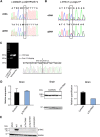TBK1 Mutation Spectrum in an Extended European Patient Cohort with Frontotemporal Dementia and Amyotrophic Lateral Sclerosis
- PMID: 28008748
- PMCID: PMC5324646
- DOI: 10.1002/humu.23161
TBK1 Mutation Spectrum in an Extended European Patient Cohort with Frontotemporal Dementia and Amyotrophic Lateral Sclerosis
Abstract
We investigated the mutation spectrum of the TANK-Binding Kinase 1 (TBK1) gene and its associated phenotypic spectrum by exonic resequencing of TBK1 in a cohort of 2,538 patients with frontotemporal dementia (FTD), amyotrophic lateral sclerosis (ALS), or FTD plus ALS, ascertained within the European Early-Onset Dementia Consortium. We assessed pathogenicity of predicted protein-truncating mutations by measuring loss of RNA expression. Functional effect of in-frame amino acid deletions and missense mutations was further explored in vivo on protein level and in vitro by an NFκB-induced luciferase reporter assay and measuring phosphorylated TBK1. The protein-truncating mutations led to the loss of transcript through nonsense-mediated mRNA decay. For the in-frame amino acid deletions, we demonstrated loss of TBK1 or phosphorylated TBK1 protein. An important fraction of the missense mutations compromised NFκB activation indicating that at least some functions of TBK1 are lost. Although missense mutations were also present in controls, over three times more mutations affecting TBK1 functioning were found in the mutation fraction observed in patients only, suggesting high-risk alleles (P = 0.03). Total mutation frequency for confirmed TBK1 LoF mutations in the European cohort was 0.7%, with frequencies in the clinical subgroups of 0.4% in FTD, 1.3% in ALS, and 3.6% in FTD-ALS.
Keywords: ALS; FTD; NFκB luciferase reporter assay; TANK-Binding Kinase 1; TBK1; amyotrophic lateral sclerosis; frontotemporal dementia; mutations.
© 2016 The Authors. **Human Mutation published by Wiley Periodicals, Inc.
Figures



Similar articles
-
Association between TBK1 mutations and risk of amyotrophic lateral sclerosis/frontotemporal dementia spectrum: a meta-analysis.Neurol Sci. 2018 May;39(5):811-820. doi: 10.1007/s10072-018-3246-0. Epub 2018 Jan 18. Neurol Sci. 2018. PMID: 29349657 Review.
-
TBK1 mutation frequencies in French frontotemporal dementia and amyotrophic lateral sclerosis cohorts.Neurobiol Aging. 2015 Nov;36(11):3116.e5-3116.e8. doi: 10.1016/j.neurobiolaging.2015.08.009. Epub 2015 Aug 14. Neurobiol Aging. 2015. PMID: 26476236
-
Clinical features of TBK1 carriers compared with C9orf72, GRN and non-mutation carriers in a Belgian cohort.Brain. 2016 Feb;139(Pt 2):452-67. doi: 10.1093/brain/awv358. Epub 2015 Dec 15. Brain. 2016. PMID: 26674655 Free PMC article.
-
Common and rare TBK1 variants in early-onset Alzheimer disease in a European cohort.Neurobiol Aging. 2018 Feb;62:245.e1-245.e7. doi: 10.1016/j.neurobiolaging.2017.10.012. Epub 2017 Oct 25. Neurobiol Aging. 2018. PMID: 29146049
-
Association of Mutations in TBK1 With Sporadic and Familial Amyotrophic Lateral Sclerosis and Frontotemporal Dementia.JAMA Neurol. 2017 Jan 1;74(1):110-113. doi: 10.1001/jamaneurol.2016.3712. JAMA Neurol. 2017. PMID: 27892983 Review.
Cited by
-
Novel Intronic Mutations of TBK1 Promote Aberrant Splicing Modes in Amyotrophic Lateral Sclerosis.Front Mol Neurosci. 2022 Feb 24;15:691534. doi: 10.3389/fnmol.2022.691534. eCollection 2022. Front Mol Neurosci. 2022. PMID: 35283724 Free PMC article.
-
Rare TBK1 variants in patients with frontotemporal dementia and amyotrophic lateral sclerosis in a Chinese cohort.Transl Neurodegener. 2018 Dec 4;7:31. doi: 10.1186/s40035-018-0136-6. eCollection 2018. Transl Neurodegener. 2018. PMID: 30534373 Free PMC article.
-
Gene mutations in a Han Chinese Alzheimer's disease cohort.Brain Behav. 2019 Jan;9(1):e01180. doi: 10.1002/brb3.1180. Epub 2018 Dec 14. Brain Behav. 2019. PMID: 30549411 Free PMC article.
-
Protein Quality Control and the Amyotrophic Lateral Sclerosis/Frontotemporal Dementia Continuum.Front Mol Neurosci. 2017 May 10;10:119. doi: 10.3389/fnmol.2017.00119. eCollection 2017. Front Mol Neurosci. 2017. PMID: 28539871 Free PMC article.
-
A Novel TBK1 Variant (Lys694del) Presenting With Corticobasal Syndrome in a Family With FTD-ALS Spectrum Diseases: Case Report.Front Neurol. 2022 Mar 4;13:826676. doi: 10.3389/fneur.2022.826676. eCollection 2022. Front Neurol. 2022. PMID: 35309588 Free PMC article.
References
-
- Le Ber I, De Septenville A, Millecamps S, Camuzat A, Caroppo P, Couratier P, Blanc F, Lacomblez L, Sellal F, Fleury M‐C, Meininger V, Cazeneuve C, et al. 2015. TBK1 mutation frequencies in French frontotemporal dementia and amyotrophic lateral sclerosis cohorts. Neurobiol Aging 36:3116.e5–3116.e8. - PubMed
-
- Borroni B, Bonvicini C, Alberici A, Buratti E, Agosti C, Archetti S, Papetti A, Stuani C, Di Luca M, Gennarelli M, Padovani A. 2009. Mutation within TARDBP leads to frontotemporal dementia without motor neuron disease. Hum Mutat 30:E974–E983. - PubMed
-
- Brooks BR, Miller RG, Swash M, Munsat TL. 2000. El Escorial revisited: revised criteria for the diagnosis of amyotrophic lateral sclerosis. Amyotroph Lateral Scler Other Motor Neuron Disord 1:293–299. - PubMed
-
- Chester C, de Carvalho M, Miltenberger G, Pereira S, Dillen L, van der Zee J, Van Broeckhoven C, de Mendonça A. 2013. Rapidly progressive frontotemporal dementia and bulbar amyotrophic lateral sclerosis in Portuguese patients with C9orf72 mutation. Amyotroph Lateral Scler Frontotemporal Degener 14:70–72. - PubMed
MeSH terms
Substances
LinkOut - more resources
Full Text Sources
Other Literature Sources
Medical
Research Materials
Miscellaneous

